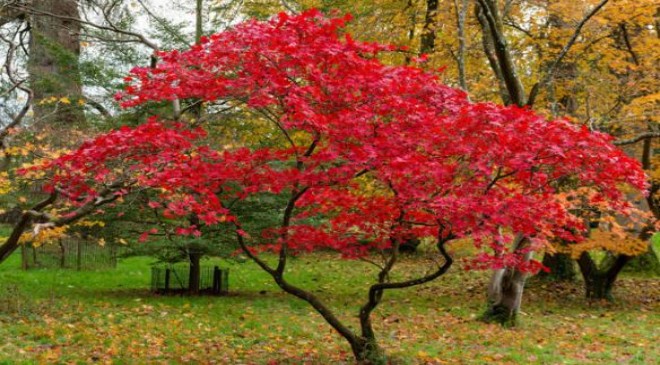Even in a small yard, adding a tree will provide vertical interest and welcome shade on those warm sunny days. But when you don’t have a lot of space, it’s important to avoid something that’ll grow really tall and block out all the available light.
Read More : Troubles for Biden not just his age in reelection campaign: POLL
Surprisingly, there are a lot of small trees to choose from. But if you can only have one, it’s nice to choose a flowering tree, so you can enjoy some springtime color or a fruiting tree that’ll reward you with tasty produce. Besides, these trees are also great for attracting birds and pollinating insects to your garden.
Planting a tree is a lovely way to add height and impact to a garden, plus it’s a great way to help create some privacy. A carefully positioned tree can block out a neighbor’s view of your patio or simply make your small yard feel like more of a sanctuary.
Here are just seven options and if you want more advice, we recommend reading about these 7 plants to create privacy in your backyard or the best trees to grow in containers.
1. Japanese Maple or Acer
Read More : What Each Zodiac Sign Can Manifest During This Week’s Full Moon
Japanese maple trees are a species of Acer and there are plenty of varieties to choose from including dwarf trees that are suited to particularly small yards. These trees are beloved for their beautiful elegant leaves, with some varieties displaying fantastically vivid shades of red, or orange throughout the entire growing season.
A Japanese maple can add a welcome flush of color amongst a sea of green leaves. They are slow growing and many stay just a few feet tall. So it’s not the best choice if you’re looking for a small tree to add some instant privacy.
Most Japanese maples are hardy enough for USDA zones 5-8. But obviously it’s worth double checking the recommendations for the variety you intend to buy. They like shady, sheltered spots, without too much bright sunlight or wind.
2. Fruit trees
Read More : The Little-Known Passport Rule You Need to Know ASAP
We’re kind of cheating by bundling all fruit trees together here. But whether an apple, pear, plum, or cherry tree, what’s better than the joy of plucking fresh organic fruit from your own tree? Well, actually, the spring blossom on these trees is reason alone to choose a fruit tree.
Most fruit trees don’t grow higher than about 20ft, but if that’s too tall, there are of course smaller and dwarf varieties that’ll grow 8- 10 feet.
The type of fruit tree you choose will depend on two things; what fruit you enjoy eating, and where you live. For example most cherry trees thrive in USDA zones 4-7. While some apple trees are hardy enough for zones 3-5. So you’ll have to do a bit of homework, but it’ll be worth it when you’re rewarded with an abundance of delicious fruit crops.
Read More : Your brain needs rest. Here are five ways to get some
3. Bay tree
The bay tree or bay laurel is a sun loving tree that’s native to the Mediterranean. It’ll give your yard a dreamy European feel, but since this tree prefers warmer climates, it’ll do best in USDA hardiness zones 7-10.
By pruning a bay tree, you can keep it to the exact size and shape that you prefer. It makes a great ornamental topiary tree in a manicured and precise garden design. If you want to use the leaves in your culinary creations, make sure you buy one of the Laurus nobilis varieties.
If left alone, some bay tree varieties will grow very tall. But bay trees are slow growing trees so with a yearly prune with the best pruning shears, you can easily keep it under control. And this evergreen tree will look lovely and green year round, so you won’t even need to get the leaf blower out in the fall.
4. Crape Myrtle
With its beautiful blooms providing a showy display from July to September, the Crape Myrtle, becomes a colorful focal point after the spring flowers have faded. The flower color varies depending on the particular crape myrtle you choose, but shades range from white to pink, purple and reds.
There’s a variety to suit most different size yards, some dwarf varieties can be kept as low as 5 feet tall, while larger trees can reach heights of 20 – 30 feet. Some varieties grow more like a shrub, while others grow as either a single or multiple trunk tree.
Read More : The Most Important Tech Company You’ve Never Heard of Is a Major Reason Computers Keep Getting Faster
There are varieties to suit USDA zones 6-10. Though it should be noted that in some areas it can be quite an invasive plant, so check your area.
5. Flowering Dogwood
The star-shaped flowers produced by this small tree appear in early spring and give way to a reddish orange berry that’s a popular snack for birds. It’s a deciduous tree and the foliage turns a beautiful shade of purple and scarlet in the fall, so it provides plenty of color and interest from spring through fall.
Some varieties are more of a shrub while others form trees that’ll grow up to 30 feet. Regarded as one of the best small flowering trees, it’s a joy to have in your garden.
It’ll work in USDA hardiness zones 5-9 and prefers a spot that’s partially shady. There’s no need to prune it, but you may have to grab the leaf blower in the fall.
Here are 5 things you need to know before buying a leaf blower and if you already own one, read our top tips on how to use a leaf blower.
Read More : Read Your Daily Horoscope: Saturday, 23 September 2023
6. Fringe tree
Just as the dogwood blossoms are fading, out come the fragrant delicate white blooms of the fringe tree. This small tree is native to the Southeastern US but is hardy from zones 3-9. The cloud-like lacey flowers are followed by purple berries that’ll encourage birds and wildlife to pay you a visit.
The scent of the flowers is particularly notable for bringing additional joy to your yard. It’s a great tree for a medium size garden. Even a very mature fringe tree won’t usually grow taller than about 20 feet, though it can spread quite wide.
The fringe tree is pretty adaptable and is generally a low maintenance tree or shrub. The main downside is that those beautiful white flowers are only around for a couple of weeks.
7. Olive tree
Read More : US general says Trump was angered by invite to wounded soldier: “Nobody wants to see that”
Adding an olive tree to your yard will instantly add a hint of Mediterranean sunshine. But, the catch is, they love warmer Mediterranean style climates. So an olive tree is only really an option if you live in US planting zones 8-10.
If you are lucky enough to have the right conditions for growing an olive tree in your yard, it’s a fantastic small tree to plant. Olive trees are fairly drought tolerant and prefer well-drained soil and a sunny location.
You’ll need to prune it hard in late winter if you want it to produce fruit. Nevertheless the long slender leaves stay year round, so it’ll look lovely even after all the other trees have lost their leaves in the fall.
If you’re looking for something that’ll grow quicky to add privacy and shade to your yard, we’ve picked out 7 fast-growing trees for shade and privacy.









































